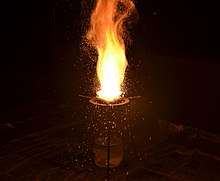Exothermic reaction
A chemical reaction is exothermic if it releases more energy than was initially supplied to it as activation energy. (The term comes from Greek ἔξω exo 'outside' and θερμός thermós 'warm', 'hot', 'heated').
The products of an exothermic reaction have a lower enthalpy 

If the reaction takes place at constant pressure (i.e. under isobaric conditions), the enthalpy decrease is numerically equal to the amount of heat released (see → Enthalpy for a more detailed explanation). In the isobaric case, therefore, the exothermic reactions are precisely those in which heat is released to the surroundings.
Occasionally, exothermic reactions are also defined sweepingly as reactions that give off heat. In the isobaric case, both definitions are identical, but beyond that they are generally not. For example, if the reaction takes place while the volume is kept constant, the amount of heat given off corresponds to the change in the internal energy of the system, not to the change in enthalpy (see → Enthalpy for a more detailed explanation). In the following, this article uses the definition used at the beginning as a reaction with negative enthalpy of reaction. This definition has the advantage that enthalpy is a state variable, so knowledge of the initial and final states is sufficient to determine the enthalpy change. The heat given off, on the other hand, is a process variable and it is generally necessary to also know details about the course of the process in order to be able to calculate it.
The contrast to the exothermic reaction is the endothermic reaction, the enthalpy of reaction of which is positive and which, in the isobaric case, absorbs the amount of heat corresponding numerically to the increase in enthalpy. If a reaction under consideration is exothermic, then the reverse reaction is endothermic, and vice versa.
If the reaction takes place in an adiabatic container, so that no heat can be exchanged with the environment, an exothermic reaction leads to an increase in temperature and an endothermic reaction to a decrease in temperature.
In physics, a nuclear reaction that releases energy is called exothermic. An exothermic nuclear fusion is, for example, hydrogen burning, as it happens in the sun. The nuclear fission of uranium, for example, is also highly exothermic.
Examples
Typical exothermic reactions are:
- Fire (combustion)
- Setting (= hardening) of concrete.
- After brief heating, iron and sulphur react to form iron sulphide under the generation of light and heat.
The mixing of substances (heat of mixing) or the adsorption and absorption of substances, for example on activated carbon or zeolites, is also often exothermic, although to a much lesser extent.
Exothermic and exergonic reactions
At first, it seems obvious to assume that exothermic reactions are precisely those reactions that take place voluntarily, and that the more heat is released, the more violent they become. In many cases, chemical reactions do indeed behave in this way. This experience led to the formulation of the principle of Thomsen and Berthelot in the early years of thermochemistry. This empirical - but not strictly valid - rule states that if reactants are brought together under isobaric and isothermal conditions so that a chemical reaction can proceed, then the resulting new equilibrium state is characterized by the fact that the process leading to it releases more heat than any other possible process. In other words, of all possible processes, the most exothermic is realized. The principle is also equivalent to saying that the realized process should make the enthalpy difference 

The existence of voluntarily occurring endothermic reactions (for example, an evaporating liquid) shows, of course, that this principle cannot claim general validity. The actual criterion is: Those reactions take place voluntarily which lead to an increase in the total entropy of the system and its environment. Under isobaric and isothermal conditions, this criterion of total entropy maximization is equivalent to minimizing the Gibbs energy of the system. A reaction that reduces the Gibbs energy of the system is called an exergonic reaction. The distinction between voluntary and involuntary reactions is equivalent to the distinction between exergonic and endergonic reactions.
An example of a chemical reaction that is endothermic but nevertheless voluntary is the decomposition of dinitrogen trioxide into nitrogen monoxide and nitrogen dioxide:
The enthalpy of reaction Δ 

The change in Gibbs energy 

At small temperatures, Δ 






However, if a reaction is accompanied by a sufficiently large entropy increase Δ 




The thermite reaction (the reduction of iron(III) oxide by aluminium) is strongly exothermic and proceeds very violently.
Search within the encyclopedia
